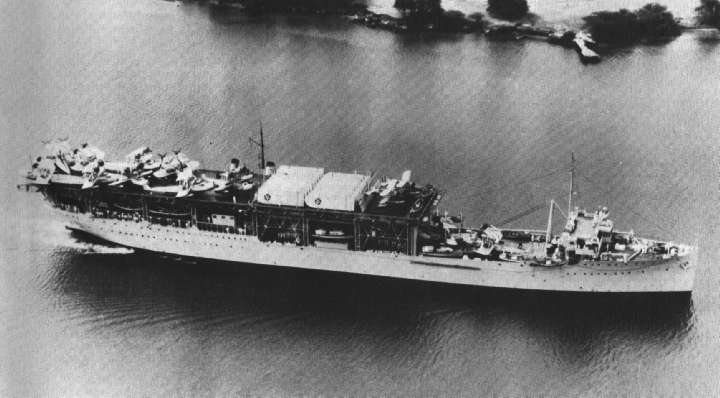

Design History
The United States' first aircraft carrier, CV-1 Langley, began its service life in a distinctly
different role. She was commissioned first as the collier Jupiter;
and her conversion was only another milestone in Jupiter's already
impressive service record. She was the prototype for U.S. turbo-electric
ships; she had been one of the first ships through the Panama Canal; and
she was an important supply vessel to the largely coal-fueled fleet.
That the United States entered carrier construction could not surprise: from the deck of U.S.S. Birmingham, and armored cruiser, the first sea-borne aircraft launch had been conducted, as had the first seaborne landing.
Still, the U.S. Navy was not initially inclined to go all the way and construct a new carrier. Designs, however, ran from new-construction 22,000 ton carriers to designs adapted from battlecruisers then under contemplation.
While these trails of thought later led to the construction of the Lexington class carriers, in the immediate post-war years, the Navy did not receive the funding necessary to procure a new carrier. However, Congress did appropriate funds to rebuild the collier Jupiter, which, with its large holds and powerful cranes already was quite well suited to aircraft transport.
Entering Norfolk Navy Yard in March 1919, the brand-new carrier left the yard almost exactly two years later. Her design had not been greatly altered; her forward coal hold now held aviation gasoline, the others formed a "hangar deck" -- although that deck was only used to assemble the planes, which were readied on the flight deck with bombs etc.
Her flight deck covered the entire length of the ship, completely unobstructed, as the bridge remained in its former position and was covered by the deck. Smoke disposal was by means of a funnel to the port side, which, however, was found unsatisfactory and replaced by twin funnels that could be lowered to the horizontal during flight operations.
All in all, Langley's conversation was crude, noting especially that the airplane lift which elevated planes from the "hangar" deck to the flight deck was, in the lowest position, not level with the "hangar deck", obstructing its loading with planes severely.
Service
Langley was an experimental
carrier, and as such, provided most valuable services until the larger
Lexington and Saratoga arrived in the fleet in 1928. Especially
under Captain Joseph Mason Reeves, later CinCUS, the handling of flight
operations and other vital elements of carrier operations were refined
to make full use of the more powerful Lexington class. Without the
services rendered by Langley in the years up to 1928, U.S. carrier
operations would have to be learned anew aboard the heavy carriers, which
now benefitted from the trained personnel coming from Langley.
As she was an experimental vessel, Langley did not count against the Washington Treaty's tonnage restrictions, but when the Second Vinson-Trammel Act, calling for the construction of Wasp, counted Langley's tonnage to the total permissible to the U.S. Navy, the old vessel was refitted as a seaplane carrier, losing the forward half of her flight deck. Carrying Army P-40 fighter planes to Java in 1942 she was attacked and sunk by Japanese aircraft on February 27th, 1942.
Ships in class:
CV-1 Langley
|
|
Displacements:
Standard: 13.900 tons Full: 15.150 tons Length: 159.77m / 542ft 2,5" Beam: 19.85m / 65ft 2 13/16" Draft (Full Load): 9.20m / 22ft 1" Height: ???? / ???? Crew (Officers/Men): 53/415 Endurance: ???? Speed: 15.5 knots |
|
|
The ship possessed no armor |
|
|
(As designed):
Main: 4 x 127mm L/25 Secondary: None AA: None Aviation: 12 Fighters 12 Spotters 4 Torpedo Bombers 6 Other Seaplanes |